
An extraordinarily talented team of students and faculty, including Broadway hoofer-turned-choreographer extraordinaire Andrew Palermo, have joined forces to create a Spring Awakening so fresh and original, my guess is that book writer-lyricist Steven Sater and composer Duncan Sheik might have a hard time choosing between the Broadway production and UC Irvine’s thoroughly original re-envisioning of their ground-breaking 2007 Tony-winning Best Musical.
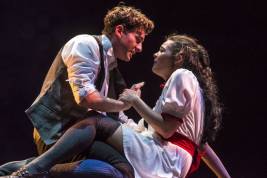 Frank Wedenkind’s play Frühlings Erwachen (that’s Spring Awakening in German) broke plenty of ground itself back in 1891 with its depiction of on-and/or-offstage masturbation, child abuse, bondage, rape, abortion, and suicide among 14-year-olds just now awakening to their sexuality. No wonder, then, that Wedenkind’s late nineteenth-century shocker wasn’t staged on Broadway until 1916 and ended up closing after a single performance.
Frank Wedenkind’s play Frühlings Erwachen (that’s Spring Awakening in German) broke plenty of ground itself back in 1891 with its depiction of on-and/or-offstage masturbation, child abuse, bondage, rape, abortion, and suicide among 14-year-olds just now awakening to their sexuality. No wonder, then, that Wedenkind’s late nineteenth-century shocker wasn’t staged on Broadway until 1916 and ended up closing after a single performance.
Very much a trailblazer in its own way, Sater and Sheik’s musical has proved considerably more successful than its source material, winning eight Tonys including Best Musical, Book, Score, and Choreography. Following nearly 900 performances on Broadway, a pair of National Tours, and numerous regional production, Spring Awakening’s latest incarnation is as this year’s annual big-stage UCI musical—the overall finest of the ten terrific college or university productions I’ve reviewed over the past twelve months.
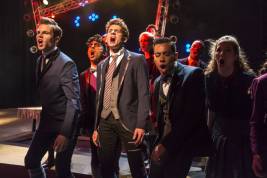 Spring Awakening (The Musical) follows Wedekind’s storylines, though thankfully not too much to the letter. There are its two teen heroes, the handsome, popular, self-confident Melchior (Jeff Salsbury) and his introverted, inhibited, wet-dream-plagued classmate Moritz (Jake Saenz), and its heroine, the all-too-innocent but no less sexually inquisitive girl-next-door Wendla (Abbey Howe). There are also Melchior and Moritz’s ever-horny classmates and Wendla’s equally randy girlfriends. A single pair of actors stand in for all the adults in these teens’ lives.
Spring Awakening (The Musical) follows Wedekind’s storylines, though thankfully not too much to the letter. There are its two teen heroes, the handsome, popular, self-confident Melchior (Jeff Salsbury) and his introverted, inhibited, wet-dream-plagued classmate Moritz (Jake Saenz), and its heroine, the all-too-innocent but no less sexually inquisitive girl-next-door Wendla (Abbey Howe). There are also Melchior and Moritz’s ever-horny classmates and Wendla’s equally randy girlfriends. A single pair of actors stand in for all the adults in these teens’ lives.
What makes Spring Awakening work so brilliantly is not just Sater’s streamlining of Wedekind’s melodramatic plot threads but also singer-songwriter-pop star Sheik’s catchy alternative rock score, the likes of which had probably never before been heard on a Broadway stage.
The show begins quietly, with sexually burgeoning Wendla wondering if she’ll ever be told the truth about man-woman relations in “Mama Who Bore Me,” followed by a very funny sequence in which her highly embarrassed mother (Melissa Glasgow) avoids the question entirely, an omission which proves ultimately disastrous. The song takes on a rock beat as Wendla’s girlfriends join her in a reprise, after which we visit Melchior and Moritz in Latin class, the former attempting to rescue the latter from the ire of their monster of a teacher (Alex White), when the burning need to express what’s going on inside their minds and bodies suddenly erupts.
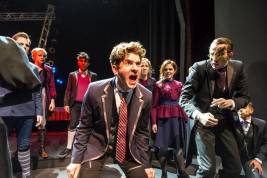 The first chords of “The Bitch Of Living” had Broadway’s Melchior suddenly drawing from within his school uniform a previously-hidden mike, a gesture so defiant, unexpected, and utterly thrilling that it made me a Spring Awakening fan for life, so much so that, for this reviewer at least, much of Spring Awakening’s magic has come from those hand-held mikes which take us in an instant from 19th Century reality into these characters’ 21st Century emotions. In a previous review, I even went so far as to give potential Spring Awakening directors the following advice: If you can’t do it with hand-held microphones, don’t do it at all.
The first chords of “The Bitch Of Living” had Broadway’s Melchior suddenly drawing from within his school uniform a previously-hidden mike, a gesture so defiant, unexpected, and utterly thrilling that it made me a Spring Awakening fan for life, so much so that, for this reviewer at least, much of Spring Awakening’s magic has come from those hand-held mikes which take us in an instant from 19th Century reality into these characters’ 21st Century emotions. In a previous review, I even went so far as to give potential Spring Awakening directors the following advice: If you can’t do it with hand-held microphones, don’t do it at all.
Not only does director C. Ryanne Laratonda dispense with the hand mikes, in the mostly not-quite-era-specific time zone she and her phenomenal team of designers have given this Spring Awakening, they are simply not missed. Add to that Palermo’s brilliantly innovative choreography, with nary a trace of Bill T. Jones’ stomps and back kicks and leaps and jumps, and you have a production that is the very definition of original, and dance moves that might easily have won Palermo Broadway’s biggest award had he been there/done that first.
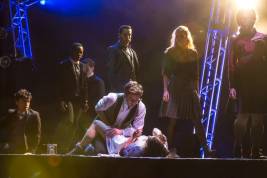 The lives of UCI’s Melchior, Moritz, Wendla, and the rest unfold on scenic designer David Phillips’ strikingly abstract set, backed by three large interlocking metal girders onto which are attached banks of lights, while the back upstage wall is adorned with patterns of large circular dots which change from color to color as songs and scenes change from mood to mood. Phillips’ set may lack the assorted hanging paraphernalia, classroom and otherwise, that have characterized many previous Spring Awakenings, however if there’s anything his set is not, it’s visually dull. Add to that the many ways Laratonda finds to keep most of the cast onstage throughout most of the show in constantly changing configurations as both participants and observers, and you’ve got as exciting-to-look-at a Spring Awakening as I’ve seen.
The lives of UCI’s Melchior, Moritz, Wendla, and the rest unfold on scenic designer David Phillips’ strikingly abstract set, backed by three large interlocking metal girders onto which are attached banks of lights, while the back upstage wall is adorned with patterns of large circular dots which change from color to color as songs and scenes change from mood to mood. Phillips’ set may lack the assorted hanging paraphernalia, classroom and otherwise, that have characterized many previous Spring Awakenings, however if there’s anything his set is not, it’s visually dull. Add to that the many ways Laratonda finds to keep most of the cast onstage throughout most of the show in constantly changing configurations as both participants and observers, and you’ve got as exciting-to-look-at a Spring Awakening as I’ve seen.
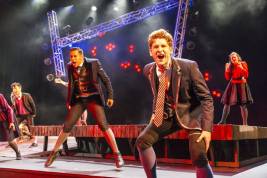 Palermo’s choreography is simply mesmerizing, built on angular movements and poses, individualized for each performer and all the more stunning when performed in counterpoint to each other. In fact, there seems hardly a moment when characters aren’t doing some sort of choreographed moves, even in straightforward vocal solos like Ilse’s “Blue Wind.” There are times when these nearly adult teens appear almost like marionettes manipulated by invisible stings, a fitting expression of teens who feel manipulated by the adults around them and unable to live their lives as they see fit. Some dance numbers made me wonder if Agnes de Mille might be choreographing like this were she alive today, which in this reviewer’s book is high praise indeed.
Palermo’s choreography is simply mesmerizing, built on angular movements and poses, individualized for each performer and all the more stunning when performed in counterpoint to each other. In fact, there seems hardly a moment when characters aren’t doing some sort of choreographed moves, even in straightforward vocal solos like Ilse’s “Blue Wind.” There are times when these nearly adult teens appear almost like marionettes manipulated by invisible stings, a fitting expression of teens who feel manipulated by the adults around them and unable to live their lives as they see fit. Some dance numbers made me wonder if Agnes de Mille might be choreographing like this were she alive today, which in this reviewer’s book is high praise indeed.
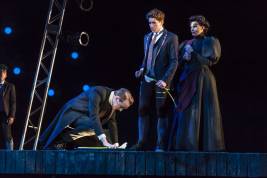 Some of director Laratonda’s and Palermo’s most memorable sequences come in Spring Awakening’s quieter moments: the Pink Floyd-esque “Touch Me,” in which the youthful cast of characters express their desire for intimate physical contact; the anthem-like “I Believe,” which sets the stage for Melchior and Wendla’s lovemaking; and the exquisitely sad “Left Behind,” sung at a funeral for one of the teens. In all three cases, director and choreographer had me feeling as if I were seeing Spring Awakening for the very first time.
Some of director Laratonda’s and Palermo’s most memorable sequences come in Spring Awakening’s quieter moments: the Pink Floyd-esque “Touch Me,” in which the youthful cast of characters express their desire for intimate physical contact; the anthem-like “I Believe,” which sets the stage for Melchior and Wendla’s lovemaking; and the exquisitely sad “Left Behind,” sung at a funeral for one of the teens. In all three cases, director and choreographer had me feeling as if I were seeing Spring Awakening for the very first time.
As always, Sater and Sheik’s alternative rock songs make the struggles of Melchior, Wendla, and Moritz seem every bit as relevant to today’s American teens as they were to their their German counterparts over a century ago, almost as if twenty-first century souls were inhabiting these long-deceased youths. Spring Awakening’s adolescents may have been born in the 1870s, but their dilemmas (like the consequences of Wendla’s insufficient sexual education) still ring true today.
The triple-threats who bring these characters to life at UCI are some of the best among the nine different casts I’ve seen so far.
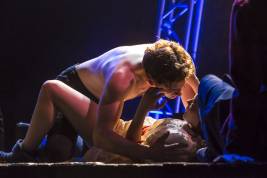 Salsbury gives Melchior the fervor and sensitivity of a budding poet in a striking star turn that portends great things ahead. Thumbs up too to Howe’s particularly spunky take on Wendla too, no shrinking violet this time round but every bit as lovely as her predecessors.
Salsbury gives Melchior the fervor and sensitivity of a budding poet in a striking star turn that portends great things ahead. Thumbs up too to Howe’s particularly spunky take on Wendla too, no shrinking violet this time round but every bit as lovely as her predecessors.
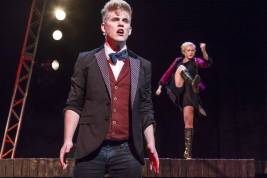 As for Saenz, versatility should be this young performer’s middle name, his passionate, troubled Moritz a far cry from the boy-next-door hoofer he played in last year’s UCI musical Dames At Sea, to name just one of several show’s in which I’ve seen Saenz impress.
As for Saenz, versatility should be this young performer’s middle name, his passionate, troubled Moritz a far cry from the boy-next-door hoofer he played in last year’s UCI musical Dames At Sea, to name just one of several show’s in which I’ve seen Saenz impress.
All three leads sing gloriously, as do their castmates.
Marlena Mack is a stunner as Ilsa, thrown out of a hellish home and grown pseudo-sophisticated in the artists’ colony she now calls home. Réanna Morris’s Martha is a boiling caldron of anger at the abuse she is forced to submit to and about which she sings in the powerful “The Dark I Know Well.” Rachelle Rose Clark and Molly Sampson complete Wendla’s circle of friends as Thea and Anna—and splendidly so.
Felix Omar’s seductive Hanschen and Ben Gibson’s eager-to-be-seduced Ernst provide some sensationally played and sung comic relief to Act Two’s darkness, though truth be told, I’ve come to prefer it when this scene is directed to be played as an honest expression of adolescent same-sex love rather than for laughs. Michael Mayo and Anthony Cloyd do standout work too as mother-fixated Otto and piano teacher-obsessed Georg.
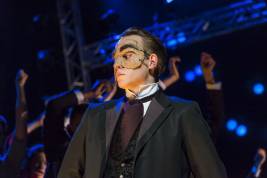 Glasgow and White get the plum assignment of playing each and every adult role, and do so quite marvelously, creating characters as distinct as the Grimm Brothers-esque villains Fraulein Knuppeldick and Headmaster Knochenbruch, Melchior’s loving mother Fanny and Wendla’s head-in-the-sand mom Frau Bergmann, Moritz’s domineering father Herr Stiefel and the well-meaning yet ineffectual Doctor von Brausepulver, and numerous others. Director Laratonda’s decision to have each adult character wear his or her own mask is an inspired one, not only differentiating the various characters they play but distinguishing these young actors from their same-aged UCI classmates.
Glasgow and White get the plum assignment of playing each and every adult role, and do so quite marvelously, creating characters as distinct as the Grimm Brothers-esque villains Fraulein Knuppeldick and Headmaster Knochenbruch, Melchior’s loving mother Fanny and Wendla’s head-in-the-sand mom Frau Bergmann, Moritz’s domineering father Herr Stiefel and the well-meaning yet ineffectual Doctor von Brausepulver, and numerous others. Director Laratonda’s decision to have each adult character wear his or her own mask is an inspired one, not only differentiating the various characters they play but distinguishing these young actors from their same-aged UCI classmates.
Musical director Daniel Gary Busby gets his cast singing to perfection (making the Sater’s lyrics every bit as important as Shiek’s melodies) as well as conducting a Broadway-caliber pit orchestra made up of Greg Adamson, Brian Boyce, Steve Carnelli, Wan-Chin Chang, Scott Cokley, Carlos Rivera, and Sara Rosas. Josh Fehrmann’s crystal-clear sound design insures that vocals and orchestra are pitch-perfectly mixed.
Julie Carr’s costumes are some of the very best I’ve seen in a Spring Awakening, a combination of vintage and funky that make it entirely reasonable that these 19th Century teens should break into 21st Century song. Wendla’s scarlet Act Two blouse is an especially brilliant costume design stroke.
Associate choreographer Samantha Jo Harvey receives a “Special Thanks” mention in the program as does The “Palermo Project” class “for their choreographic contributions—Emma Delaney, Shira Jackman, Madisen Hope Johnson, and cast member Omar. Byron Batista is hair/wig and makeup consultant, scoring A+ for all three. Other program thanks go to OenergyLIGHTING, Inc. and Illumination Dynamics. Anne L. Hitt is stage manager.
At nine productions and counting, Spring Awakening is a musical I have relished seeing again and again, each time with a fresh new director’s concept and choreographer’s vision. The original Broadway team’s concept/vision won them a well-earned eight Tonys. Laratonda and Palermo and their superlative team of theatrical artists, including many hardly out of their teens, deserve equal recognition for this extraordinary production.
UCI Claire Trevor Theatre, UC Irvine Campus, Irvine.
http://drama.arts.uci.edu/onstage.html
–Steven Stanley
June 6, 2012
Photos: Paul Kennedy


 Since 2007, Steven Stanley's StageSceneLA.com has spotlighted the best in Southern California theater via reviews, interviews, and its annual StageSceneLA Scenies.
Since 2007, Steven Stanley's StageSceneLA.com has spotlighted the best in Southern California theater via reviews, interviews, and its annual StageSceneLA Scenies.







 COPYRIGHT 2024 STEVEN STANLEY :: DESIGN BY
COPYRIGHT 2024 STEVEN STANLEY :: DESIGN BY